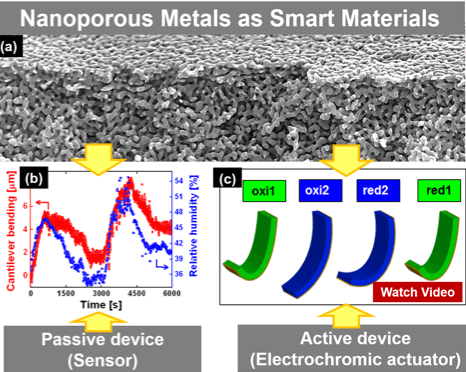Actuation and mechanical-to-electrical energy generation
Students involved:
PhD students: Lin Wang, Sam Welborn
Undergraduate students: Alexander Proschel

Figure 1: (a) Monolithic nanoporous Au
(b) Nanoporous Au used as passive humidity sensor/actuator [2] (c) Monolithic nanoporous Au/PANI composite used as active electrochromic actuator. [3] (Online supporting Video available on the following link: https://youtu.be/yQjPHs71GLs [3].[/caption]
‘Artificial muscles’ are materials that can mimic the expansion and contraction property of human skeletal muscles upon application of an outside stimulus. Nanoporous metals and their composites represent an emerging class of inorganic artificial muscles.The actuation mechanism in nanoporous metals is based on their electronic charge-induced strain property. Typically, modifying the density of free electrons at the interface of a high-surface-to-volume ratio nanoporous metal gives rise to changes in the surface stress of these materials. Due to the high-surface-to-volume ratio of nanoporous metals, changes in their surface stress induces in turn detectable macroscopic reversible strains of the order of 0.1% (or higher) in their bulk. As such, nanoporous metals are commonly referred to as metallic muscles.[1]
[1] Ray H. Baughman, Science 300, 268-269, 2003. DOI: 10.1126/science.1082270
Previously, we took advantage of this concept to develop relative humidity sensors using nanoporous Au films with high surface-to-volume ratios (see Figure 1a). Our nanoporous Au-based mechanical humidity sensor was able to generate large displacements in response to changes in the relative humidity as shown in Figure 1b [2]. In addition, we have also developed an ultrasmart electrochromic composite actuator made of polyaniline (PANI) grown into the pores of nanoporous Au, which was able to undergo both dimensional changes and changes in colour simultaneously as illustrated in Figure 1c [3].
References:
[2] E. Detsi, Z.G. Chen, W.P. Vellinga, P.R. Onck, J.T.M. De Hosson, Appl. Phys. Lett. 99 (2011). doi:10.1063/1.3625926)
[3] E. Detsi, P.R. Onck, J.T.M. De Hosson, Appl. Phys. Lett. 103 (2013). doi:10.1063/1.4827089)
A video showing these simultaneous changes in dimension and in color is available online on the following link: https://youtu.be/yQjPHs71GLs.
So far, research effort in the field of nanoporous metal-based sensors and actuators focus on the conversion of electrical energy into mechanical work. The reverse process (mechanical-to-electric energy conversion) has rarely been explored in nanoporous metals. This research is therefore aimed at harvesting electrical signals from mechanical deformations in nanoporous metal-based artificial muscles [4].
[4] S.H. Kim, …, R.H. Baughman, Science 357, 773-778, 2017. DOI: 10.1126/science.aam8771